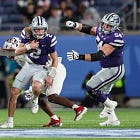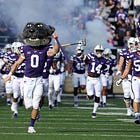Kansas State’s Midline Twist on Outside Zone
Kansas State has a toolbox full of outside zone variations, but one stands out as both rare and highly effective: Outside Zone Midline. It's a creative twist on a classic concept, something you’d expect from Chip Kelly’s old playbooks or North Dakota State teams of the past.
This version alleviates stress on two of the most critical blocks in traditional outside zone. First, the block on the nose or shade is simplified by letting the guard pin while the center pulls. That exchange not only opens a cleaner path to the second level but also creates a natural cutback lane for the running back. Second, it removes the guesswork from the backside guard. He no longer has to fight for leverage, he's free to climb immediately, cutting off second-level defenders with speed and confidence. The final piece, the quarterback reads the 3- or 4-tech. If the defense flies over the top, the QB punishes the over-pursuit.
It’s not your typical modern zone scheme, but it’s a creative throwback that helps solve real problems for the Wildcats’ offense.
Outside Zone
Here’s a 10 personnel, 2x2 look from Kansas State running Outside Zone Midline against a 4-2 box. The front side guard does a textbook job pinning the shade, which lets the center pull and wrap for the play-side inside backer. Two other key blocks stand out: the backside guard immediately climbs and seals the backside linebacker, no longer concerned with leverage, he’s just racing to the second level. Meanwhile, the play-side tackle takes the defensive end where he wants to go, essentially turning it into kick creating an alley inside.
The ball ends up hitting tight inside, almost like a gap scheme, right off the hip of the pulling center. It’s outside zone in structure, but with the downhill angle and interior entry of pin & pull, which makes it a nightmare for over-pursuing defenses.
In this example, Kansas State runs Outside Zone Midline out of 11 personnel against a Tite front. The front side operates just like the previous rep, guard pins the nose, and the tackle does a great job reaching the 4-tech. But the real difference here is what happens next. With the defense in a light box, the center is free to climb all the way to the third level. And anytime a lineman gets to the safety, you’re usually looking at a chunk gain.
This variation doesn’t just clean up the first-level picture, but creates vertical seams that stress light-box defenses trying to play both gap integrity and pursuit speed.
The final look comes from a 12 personnel set against an Under front. Structurally, it mirrors the previous examples, guard pins the shade, center climbs clean to the second level, and the backside guard gets a solid cutoff on the pursuit. The added tight end helps firm up the edge, and the running back presses play side, and makes a nice cut another big gain.
Same concept, different structure, but the result is consistent: clean leverage, easy angles, and a backfield read that punishes aggressive fronts.
Midline
Kansas State layers in a true midline read to this Outside Zone variation. In this rep, post-snap movement forces the read onto the interior linebacker. The quarterback reads him while the backside tackle accounts for the defensive end. To keep the numbers even and the conflict alive, they tag a Now screen to the perimeter, giving the QB a clean pre-snap or post-snap option if the box count shifts late.
It’s a smart way to build answers into the base concept, read a conflict defender, control the edge, and force the defense to play honest across the board.
Here’s another look at the QB pull off the midline read, but with a twist. Kansas State motions the Z receiver across the formation to lead up on the third-level defender. The defense brings pressure out of an odd front, which muddies the picture a bit post-snap, but the quarterback makes a decisive read and turns it into a positive gain.
It’s a smart add-on. That motioned lead gives the QB a blocker in space and helps clean up the numbers when the defense starts getting exotic with pressure looks.
Kansas State’s Outside Zone Midline is a perfect example of how old-school ideas can solve new-school problems. It simplifies key blocks, punishes over-pursuit, and adds a layer of decision-making that puts stress on every level of the defense. Whether it’s out of 10, 11, or 12 personnel, the Wildcats are finding ways to get clean angles, create cutback lanes, and force defenses to defend both the width and depth of the field.
It’s not just window dressing, it’s a tactical adaptation that gives the offense answers, even against today’s most popular fronts and pressure looks. If you're looking to evolve your zone run game without overhauling your identity, this is a concept worth stealing.









